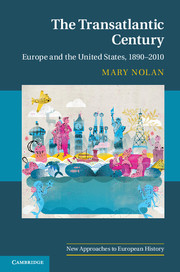Book contents
- Frontmatter
- Contents
- Illustrations
- Maps
- Tables
- Acknowledgments
- Introduction
- 1 An uncertain balance, 1890–1914
- 2 World War I: European crisis and American opportunity
- 3 Ambivalent engagement
- 4 The depression and transatlantic new deals
- 5 Strange affinities, new enemies
- 6 From world war to Cold War
- 7 Cooperation, competition, containment
- 8 Culture wars
- 9 The American Century erodes, 1968–1979
- 10 Renewed conflict and surprising collapse
- 11 A widening Atlantic
- 12 Imperial America, estranged Europe
- Suggested readings
- Index
- References
3 - Ambivalent engagement
Published online by Cambridge University Press: 05 November 2012
- Frontmatter
- Contents
- Illustrations
- Maps
- Tables
- Acknowledgments
- Introduction
- 1 An uncertain balance, 1890–1914
- 2 World War I: European crisis and American opportunity
- 3 Ambivalent engagement
- 4 The depression and transatlantic new deals
- 5 Strange affinities, new enemies
- 6 From world war to Cold War
- 7 Cooperation, competition, containment
- 8 Culture wars
- 9 The American Century erodes, 1968–1979
- 10 Renewed conflict and surprising collapse
- 11 A widening Atlantic
- 12 Imperial America, estranged Europe
- Suggested readings
- Index
- References
Summary
The specter of Americanism haunted Europe in the 1920s. The United States enjoyed unprecedented economic prosperity and political stability of a sort that war had destroyed in Europe, and the transatlantic balance of power had shifted decidedly in its favor. It was the de facto global hegemon, even though the United States was deeply ambivalent about exerting transatlantic leadership. Instead, America oscillated between isolationism and unilateralism, economic engagement and political distancing. It provided loans, exported its movies and music, and championed the Fordist model of production, but transatlantic exchanges about social reform dwindled and social policy differences magnified. And the United States remained on the margins of European political developments and outside the internationalism of the League of Nations.
Europeans evinced a much greater interest in the United States than in the prewar decades. As lender, purveyor of mass culture, economic competitor, and model of modernity, America became the focus of European hopes and fears, the site of intense debates about Europe’s present problems and possible futures, about shifting global power relations and new forms of empire. The European century was in crisis, but Europeans were deeply divided about whether it could be revived or whether the future lay with America, Russia, or both. How did Europeans in different nations and classes assess the perils and promise of Americanism? What roles did American business and government play in the building of a new postwar European order? Why did the Fordist model of mass production and mass consumption find many admirers but few emulators, while American popular culture was more influential?
- Type
- Chapter
- Information
- The Transatlantic CenturyEurope and America, 1890–2010, pp. 76 - 103Publisher: Cambridge University PressPrint publication year: 2012

